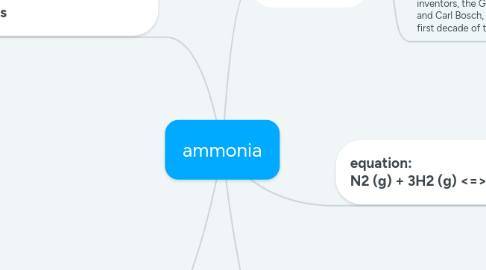
1. best conditions for the haber process
1.1. 200 atmospheric pressure
1.1.1. why 200 atm? > in order to increase the yield, the pressure should be as high as possible higher pressure, system will counteract due to LCP and lower the pressure, decrease in the number of particles per unit volume, reaction will progress in the direction that reduces the number of particles, more N2 and H2 to form NH3. however, pressure cannot be too high due to cost and safety
1.2. 450ºC
1.2.1. why 450ºC? > in order to increase the yield, the temperature should be as low as possible. lower temperature, system will counteract due to LCP and increase the temperature, in order to increase temperature, energy has to be released, thus the exothermic reaction will be favoured, more N2 and H2 to form NH3. however, temperature cannot be too low such that the rate is too slow.
1.3. iron catalyst
1.3.1. **catalyst does not increase the yield of the reaction but increases the speed of reaction.
1.3.2. why use iron and not other catalysts? > it is cheaper for industrial usage in mass production
2. le chatelier's principle
2.1. when a system in equilibrium is subjected to a change, it would respond in the opposite direction to counteract the change.
2.2. e.g.: if ammonia were to be removed when the reaction of N2 and H2 to form NH3 is in equilibrium, the reaction will produce even more ammonia to counteract the change.
3. equation: N2 (g) + 3H2 (g) <=> 2NH3 (g)
3.1. ammonia is a reversible reaction, along with the auto-ionisation of water
3.2. equilibrium state: when the rate of forward reaction (forming ammonia), is equal to the rate of backward reaction (forming nitrogen and hydrogen)
4. since ammonia is formed by reacting nitrogen with hydrogen, where do we obtain those materials?
4.1. nitrogen is one of the major components in air. thus, air is liquified to -200ºC, before separating the mixture through fractional distillation.
4.2. hydrogen can be formed using 2 methods:
4.2.1. 1. electrolysis, which is the breaking up of water molecules (however, it is not used at an industrial scale as it requires a lot of energy)
4.2.2. 2. cracking of crude oil, a.k.a petroleum, which is a mixture of hydrocarbons (substances containing only hydrogen and carbon)

